Mary Lou Maher
Agent-Centric Projection of Prompting Techniques and Implications for Synthetic Training Data for Large Language Models
Jan 14, 2025Abstract:Recent advances in prompting techniques and multi-agent systems for Large Language Models (LLMs) have produced increasingly complex approaches. However, we lack a framework for characterizing and comparing prompting techniques or understanding their relationship to multi-agent LLM systems. This position paper introduces and explains the concepts of linear contexts (a single, continuous sequence of interactions) and non-linear contexts (branching or multi-path) in LLM systems. These concepts enable the development of an agent-centric projection of prompting techniques, a framework that can reveal deep connections between prompting strategies and multi-agent systems. We propose three conjectures based on this framework: (1) results from non-linear prompting techniques can predict outcomes in equivalent multi-agent systems, (2) multi-agent system architectures can be replicated through single-LLM prompting techniques that simulate equivalent interaction patterns, and (3) these equivalences suggest novel approaches for generating synthetic training data. We argue that this perspective enables systematic cross-pollination of research findings between prompting and multi-agent domains, while providing new directions for improving both the design and training of future LLM systems.
Implications of Identity of AI: Creators, Creations, and Consequences
Feb 29, 2024Abstract:The field of Artificial Intelligence (AI) is rapidly advancing, with significant potential to transform society. However, it faces a notable challenge: lack of diversity, a longstanding issue in STEM fields. In this context, This position paper examines the intersection of AI and identity as a pathway to understand biases, inequalities, and ethical considerations in AI development and deployment. We present a multifaceted definition of AI identity, which encompasses its creators, applications, and their broader impacts. Understanding AI's identity involves analyzing the diverse individuals involved in AI's development, the technologies produced, and the social, ethical, and psychological implications. After exploring the AI identity ecosystem and its societal dynamics, We propose a framework that highlights the need for diversity in AI across three dimensions: Creators, Creations, and Consequences through the lens of identity. This paper proposes the need for a comprehensive approach to fostering a more inclusive and responsible AI ecosystem through the lens of identity.
The Tyranny of Possibilities in the Design of Task-Oriented LLM Systems: A Scoping Survey
Dec 29, 2023Abstract:This scoping survey focuses on our current understanding of the design space for task-oriented LLM systems and elaborates on definitions and relationships among the available design parameters. The paper begins by defining a minimal task-oriented LLM system and exploring the design space of such systems through a thought experiment contemplating the performance of diverse LLM system configurations (involving single LLMs, single LLM-based agents, and multiple LLM-based agent systems) on a complex software development task and hypothesizes the results. We discuss a pattern in our results and formulate them into three conjectures. While these conjectures may be partly based on faulty assumptions, they provide a starting point for future research. The paper then surveys a select few design parameters: covering and organizing research in LLM augmentation, prompting techniques, and uncertainty estimation, and discussing their significance. The paper notes the lack of focus on computational and energy efficiency in evaluating research in these areas. Our survey findings provide a basis for developing the concept of linear and non-linear contexts, which we define and use to enable an agent-centric projection of prompting techniques providing a lens through which prompting techniques can be viewed as multi-agent systems. The paper discusses the implications of this lens, for the cross-pollination of research between LLM prompting and LLM-based multi-agent systems; and also, for the generation of synthetic training data based on existing prompting techniques in research. In all, the scoping survey presents seven conjectures that can help guide future research efforts.
Understanding User Perceptions, Collaborative Experience and User Engagement in Different Human-AI Interaction Designs for Co-Creative Systems
Apr 27, 2022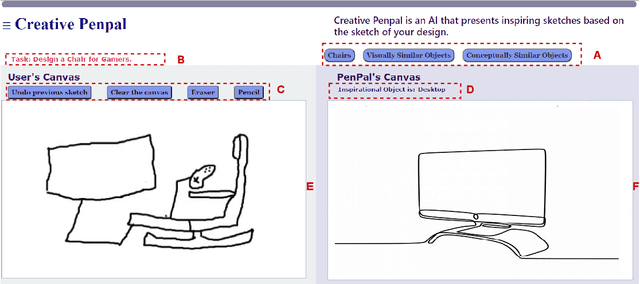

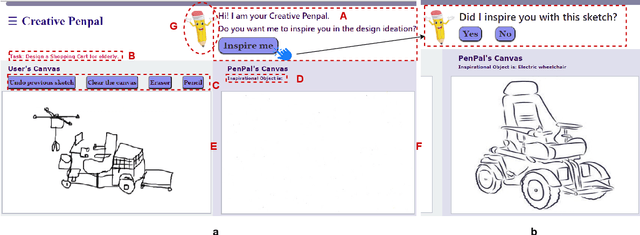
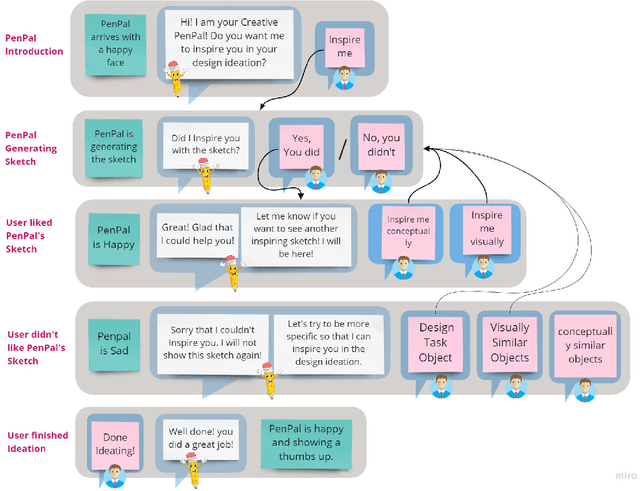
Abstract:Human-AI co-creativity involves humans and AI collaborating on a shared creative product as partners. In a creative collaboration, communication is an essential component among collaborators. In many existing co-creative systems users can communicate with the AI, usually using buttons or sliders. Typically, the AI in co-creative systems cannot communicate back to humans, limiting their potential to be perceived as partners rather than just a tool. This paper presents a study with 38 participants to explore the impact of two interaction designs, with and without AI-to-human communication, on user engagement, collaborative experience and user perception of a co-creative AI. The study involves user interaction with two prototypes of a co-creative system that contributes sketches as design inspirations during a design task. The results show improved collaborative experience and user engagement with the system incorporating AI-to-human communication. Users perceive co-creative AI as more reliable, personal, and intelligent when the AI communicates to users. The findings can be used to design effective co-creative systems, and the insights can be transferred to other fields involving human-AI interaction and collaboration.
Designing Creative AI Partners with COFI: A Framework for Modeling Interaction in Human-AI Co-Creative Systems
Apr 15, 2022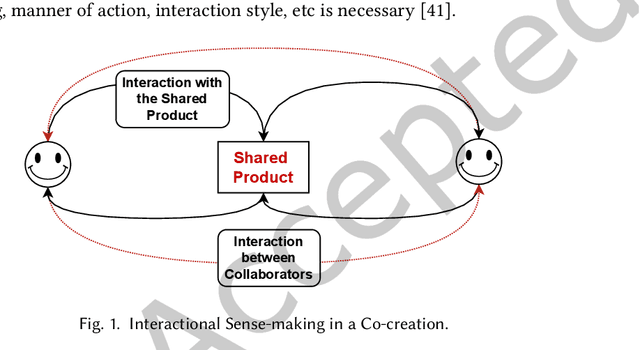
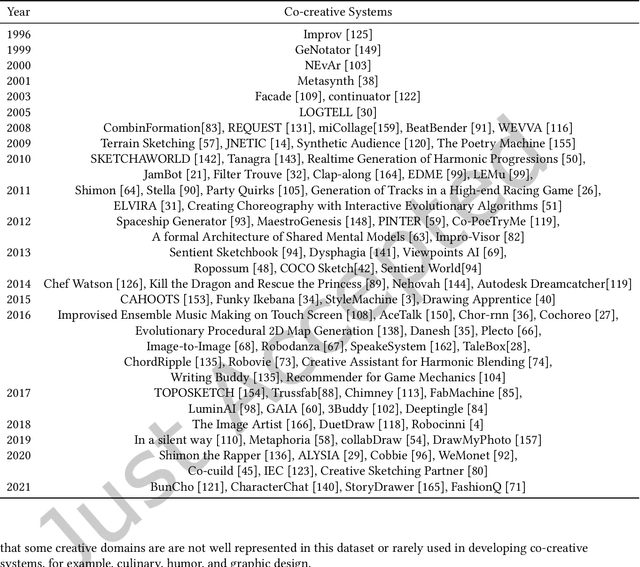
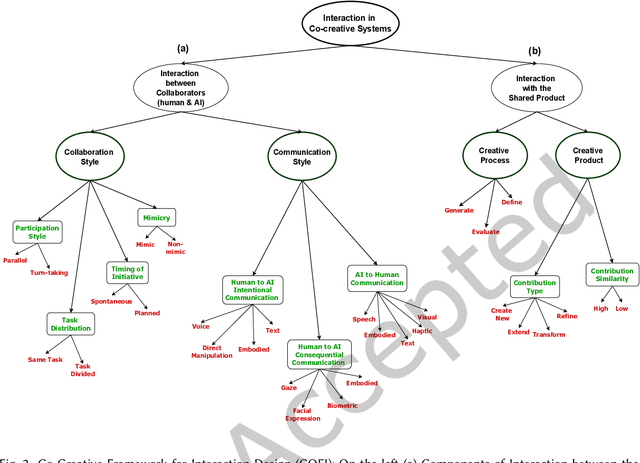
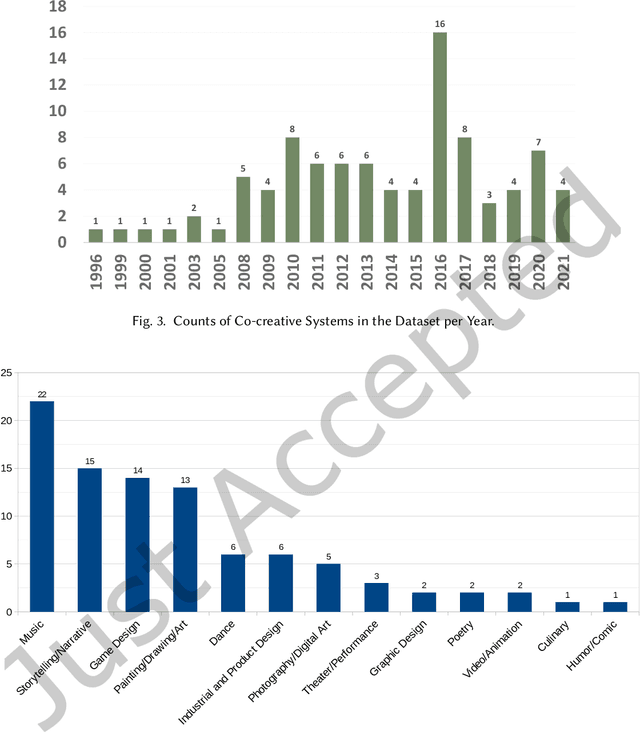
Abstract:Human-AI co-creativity involves both humans and AI collaborating on a shared creative product as partners. In a creative collaboration, interaction dynamics, such as turn-taking, contribution type, and communication, are the driving forces of the co-creative process. Therefore the interaction model is a critical and essential component for effective co-creative systems. There is relatively little research about interaction design in the co-creativity field, which is reflected in a lack of focus on interaction design in many existing co-creative systems. The primary focus of co-creativity research has been on the abilities of the AI. This paper focuses on the importance of interaction design in co-creative systems with the development of the Co-Creative Framework for Interaction design (COFI) that describes the broad scope of possibilities for interaction design in co-creative systems. Researchers can use COFI for modeling interaction in co-creative systems by exploring alternatives in this design space of interaction. COFI can also be beneficial while investigating and interpreting the interaction design of existing co-creative systems. We coded a dataset of existing 92 co-creative systems using COFI and analyzed the data to show how COFI provides a basis to categorize the interaction models of existing co-creative systems. We identify opportunities to shift the focus of interaction models in co-creativity to enable more communication between the user and AI leading to human-AI partnerships.
Identifying Ethical Issues in AI Partners in Human-AI Co-Creation
Apr 15, 2022Abstract:Human-AI co-creativity involves humans and AI collaborating on a shared creative product as partners. In many existing co-creative systems, users communicate with the AI using buttons or sliders. However, typically, the AI in co-creative systems cannot communicate back to humans, limiting their potential to be perceived as partners. This paper starts with an overview of a comparative study with 38 participants to explore the impact of AI-to-human communication on user perception and engagement in co-creative systems and the results show improved collaborative experience and user engagement with the system incorporating AI-to-human communication. The results also demonstrate that users perceive co-creative AI as more reliable, personal and intelligent when it can communicate with the users. The results indicate a need to identify potential ethical issues from an engaging communicating co-creative AI. Later in the paper, we present some potential ethical issues in human-AI co-creation and propose to use participatory design fiction as the research methodology to investigate the ethical issues associated with a co-creative AI that communicates with users.
Deep Learning in a Computational Model for Conceptual Shifts in a Co-Creative Design System
Jun 24, 2019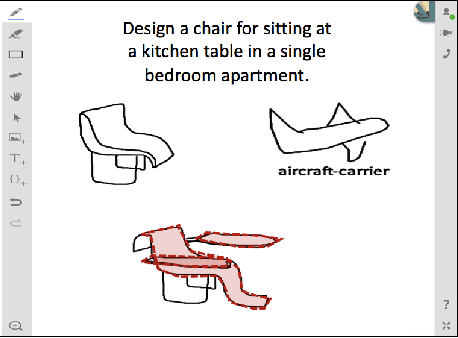

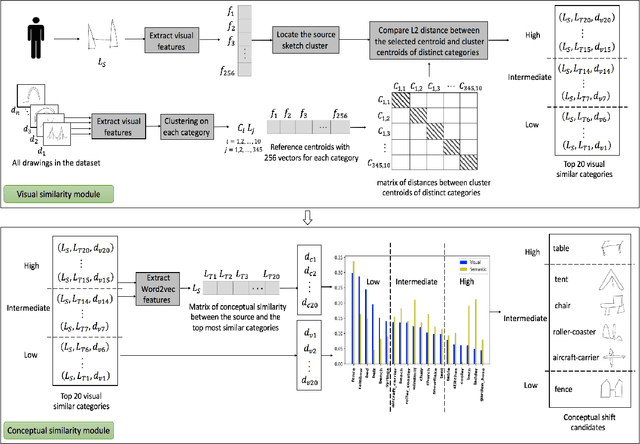

Abstract:This paper presents a computational model for conceptual shifts, based on a novelty metric applied to a vector representation generated through deep learning. This model is integrated into a co-creative design system, which enables a partnership between an AI agent and a human designer interacting through a sketching canvas. The AI agent responds to the human designer's sketch with a new sketch that is a conceptual shift: intentionally varying the visual and conceptual similarity with increasingly more novelty. The paper presents the results of a user study showing that increasing novelty in the AI contribution is associated with higher creative outcomes, whereas low novelty leads to less creative outcomes.
Evaluating Creativity in Computational Co-Creative Systems
Jul 25, 2018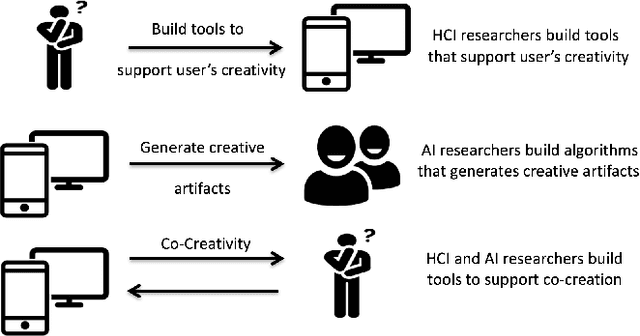
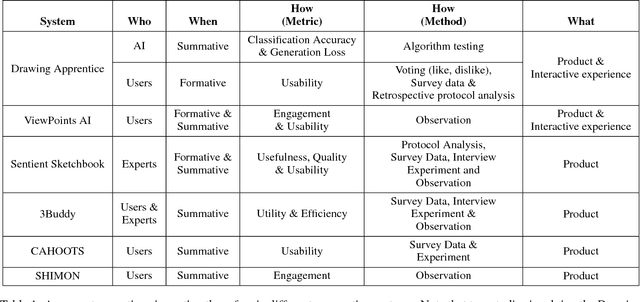

Abstract:This paper provides a framework for evaluating creativity in co-creative systems: those that involve computer programs collaborating with human users on creative tasks. We situate co-creative systems within a broader context of computational creativity and explain the unique qualities of these systems. We present four main questions that can guide evaluation in co-creative systems: Who is evaluating the creativity, what is being evaluated, when does evaluation occur and how the evaluation is performed. These questions provide a framework for comparing how existing co-creative systems evaluate creativity, and we apply them to examples of co-creative systems in art, humor, games and robotics. We conclude that existing co-creative systems tend to focus on evaluating the user experience. Adopting evaluation methods from autonomous creative systems may lead to co-creative systems that are self-aware and intentional.
Deep Learning for Identifying Potential Conceptual Shifts for Co-creative Drawing
Jan 02, 2018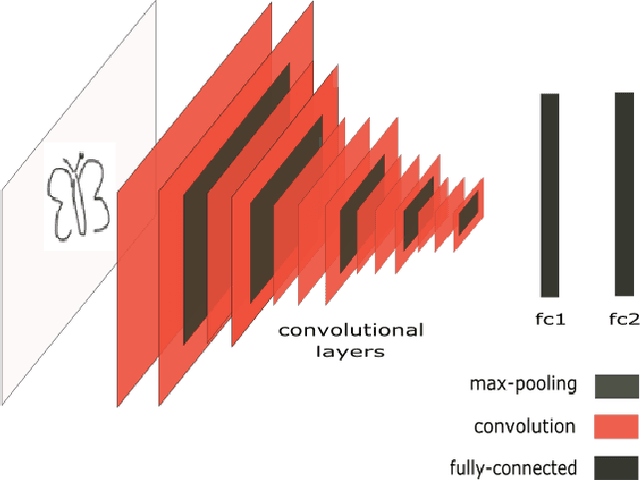
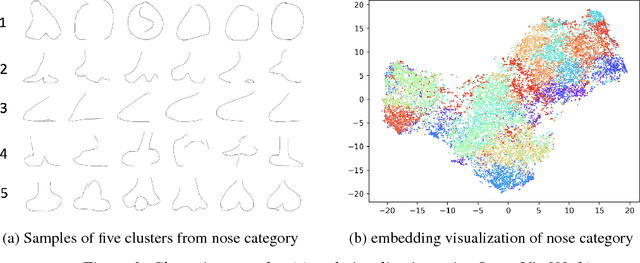
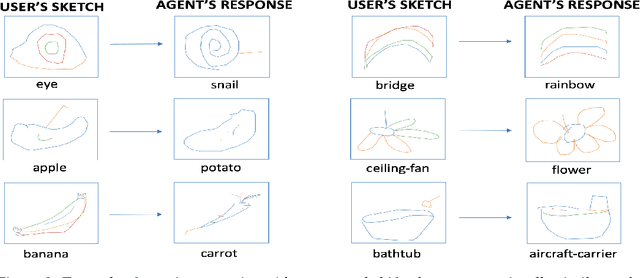
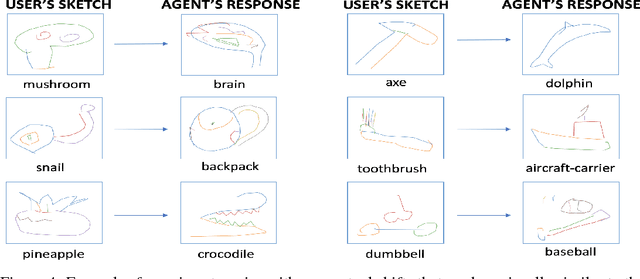
Abstract:We present a system for identifying conceptual shifts between visual categories, which will form the basis for a co-creative drawing system to help users draw more creative sketches. The system recognizes human sketches and matches them to structurally similar sketches from categories to which they do not belong. This would allow a co-creative drawing system to produce an ambiguous sketch that blends features from both categories.
 Add to Chrome
Add to Chrome Add to Firefox
Add to Firefox Add to Edge
Add to Edge